
Trout Fishing Made Easy: Best Rigs, Spoons & Techniques | JAEGER
You’re dreaming about landing your first big trout – but standing by the water, you’re left wondering: Which rig should I use? Which spoon actually works? Here’s the brutal truth about fishing the Stream fish. Most beginners quit trout fishing because they keep casting blindly. Wrong rigs, wrong spoons, wrong techniques and zero bites. But that’s about to change.
In this Trout Fishing Article, you’ll learn everything you need to catch trout like a pro. From secret rigs only insiders use to spoon tricks that drive these speckled beauties insane plus smart techniques no one ever tells you about. Whether you’re fishing in a quiet mountain stream, a deep forest lake, or a fast-flowing river, this guide will turn you from a random caster into a true trout hunter. Promise!

What is called trout?
When people talk about trout, they’re referring to one of the most popular freshwater fish families in the world, the Salmonidae family, which also includes salmon and char. But unlike salmon, most trout spend their entire lives in freshwater, hiding in cold, clear streams and lakes.
Trout are cold-water fish known for their beautiful spotted patterns and aggressive feeding behavior. They come in different shapes, sizes, and colors reaching from shiny silver to deep golden brown with vibrant red streaks. This variation isn’t just for show. Each trout species has its own preferred habitat, diet, and behavior, which can make targeting them a true test of your angling skills.
The Main Trout Species You Should Know
Rainbow Trout – Probably the most famous trout, recognized by its pinkish stripe along the body. Rainbows are aggressive feeders, making them a top choice for beginners and pros alike.
Brown Trout – Known for their dark golden body with black and red spots. They’re smart and cautious, often requiring stealthy approaches and precise presentations.
Brook Trout – Actually more related to char, these Stream fishs have a stunning pattern of light spots on a dark body with red belly stripes. Found mostly in cold, clean mountain streams.
Cutthroat Trout – Named for the distinctive red slash under their jaws. They’re native to the western US and thrive in cold, oxygen-rich waters.
Where Do Trout Live?
Most trout prefer cold, clean, and highly oxygenated water. You’ll find them in the following places.
- In mountain streams with rocky bottoms
- In deep forest lakes with cooler temperatures
- Near underwater structures like submerged logs or boulders
- In areas with strong current breaks, where they wait to ambush prey
Many anglers think the Freshwater game fish only sit in deep pools. Here’s what top guides know: Trout often hold in shallow runs and riffles, especially when food like caddis larvae or stoneflies is drifting through. That’s where you’ll catch them off guard.
What type of fishing is best for trout?
Ask five trout anglers about the best fishing style, and you’ll get ten different answers. But if you want consistent results, there are three proven trout fishing styles worth mastering.
Top Trout Fishing Styles
-
Spinning (Spin Fishing)
The classic style using a spinning rod and reel with spoons, spinners, or softbaits. Cast, retrieve, repeat. Yeah it’s that simple. -
Fly Fishing
The artful approach, using artificial flies to mimic insects. Requires more practice but incredibly rewarding, especially in streams with hatches. -
Ultralight Fishing
Using ultralight rods and reels with tiny lures or bait. Perfect for small streams and pressured trout that ignore bigger presentations.
Pros & Cons by Water Type
| Style | Streams & Rivers | Lakes & Ponds | Pros | Cons |
|---|---|---|---|---|
| Spinning | Excellent | Great | Easy to learn, versatile, covers water fast | Can spook trout in shallow streams if gear is too heavy |
| Fly Fishing | Best choice | Can work from shore | Most natural presentation, effective on selective trout | Steep learning curve, requires casting space |
| Ultralight | Great | Great | Light gear = more bites, fun fights | Less casting distance, limited to small lures/bait |
If you’re just starting out, spinning is hands-down your best bet. It’s simple, effective, and works almost anywhere. Grab a light spinning rod, some inline spinners or spoons, and you’re ready to go. Many beginners think they need heavy line for trout. Switch to 2–4 lb fluorocarbon for spinning in clear streams. The difference in bites is massive, silver bullets see everything.
Best Trout Fishing Gear for Beginners
One of the best things about trout fishing is that you don’t need a ton of gear to start catching fish. Unlike bass fishing with giant tackle boxes or deep lake trolling with downriggers, setups are simple, light, and budget-friendly. Perfect if you’re just getting into the sport.
When it comes to rods, choose an ultralight or light spinning rod. Ultralight rods around 5’6”–6’6” are perfect for small streams, while a light spinning rod between 6’–7’ is ideal for lakes and bigger rivers. Pair it with a 1000–2500 size spinning reel that has a smooth drag system and feels light in your hand and you’ll be casting all day without fatigue.
✓ 2–4 lb monofilament for small streams and finesse fishing
✓ 4–6 lb fluorocarbon for clear water lakes where trout can see everything
You’ll also need a few essential accessories to make your trout trips easy and productive.
- Landing net with rubber mesh to protect the trout’s slime coat
- Polarized sunglasses so you can spot fish under the surface glare
- Fishing pliers for quick hook removal and rig adjustments
- Trout tackle box to organize your bits, spoons, hooks, and leaders
"When it comes to baits and rigs, keep it simple but effective. That’s why JAEGER created trout-specific products that outperform standard gear."
SNAP RIG – Leader with Snap: Switch between spoons and spinners in seconds without retying knots.
SALTA – Spinner: Available in Aqua Pearl, Indigo Rose, and Black Lime – deadly flash and vibration that trigger aggressive strikes.
NEMA – Spoon: Proven flutter action in colors the speckled beauties can’t resist.
FISHING COMBO KIT: Our all-in-one trout kit with rod, reel, and the best JAEGER baits to get you started immediately.
Best Rigs for Trout Fishing
If you want to catch the Freshwater game fish consistently, you need more than just a rod and some bait. The rig you choose can be the difference between a limit of trout and going home empty-handed. Here are the top three rigs every angler should master, plus real examples of when they shine.
Carolina Rig
The Carolina Rig isn’t just for bass, it’s a killer trout setup too. It uses a sliding egg sinker above a swivel, with a leader and hook tied below. The beauty of this rig is that the fish can pick up your bait without feeling the weight, which is critical for cautious fish in cold water.
Best for:
-
Lakes where they are sitting deep near the bottom
-
River holes where these fish are hugging the substrate
Bait:
-
Worms (nightcrawlers cut in half work great)
-
Salmon eggs
Example: In early summer, the Freshwater game fish often sit at the bottom of deeper lake sections to stay cool. Cast your Carolina Rig with a JAEGER SNAP RIG leader, let it sink, and keep your line semi-tight to detect subtle bites.
Split Shot Rig
Simple but deadly, the split shot rig is one of the oldest Stream fish setups. Just pinch one or two small split shot weights 12–18 inches above your hook. This keeps your bait in the feeding zone while drifting naturally with the current.
Best for
-
Shallow streams with moderate current
-
Lake shorelines where speckled beauties cruise looking for easy meals
Bait
-
Small worm pieces
-
Mealworms
-
Single salmon eggs
-
JAEGER SALTA Trout Spinner when adding flash below the split shot for extra attraction
Example: Imagine fishing a narrow mountain stream. The Slime rockets ignore standard baits, but adding a SALTA Spinner in Aqua Pearl below your split shot adds irresistible flash and vibration.
Inline Spoon Rig
Inline spoons are deadly for aggressive River rockets. Tie a lightweight spoon like the JAEGER NEMA Trout Spoon directly to your line, cast out, and retrieve with pauses. The spoon flashes like a wounded baitfish, triggering hard strikes.
Smart tip: Many anglers retrieve too fast. Slow it down and add quick twitches, the fish often hit on the drop when the NEMA spoon flutters like a dying minnow.
JAEGER SNAP RIG – Trout Leader with Snap
The JAEGER SNAP RIG is a game changer for anglers. This ultra-stealthy fluorocarbon leader comes pre-tied with a micro snap, letting you switch between spoons, spinners, and bait hooks in seconds without retying knots. The clear fluoro stays nearly invisible underwater, making it perfect for cautious trout in pressured lakes and rivers.
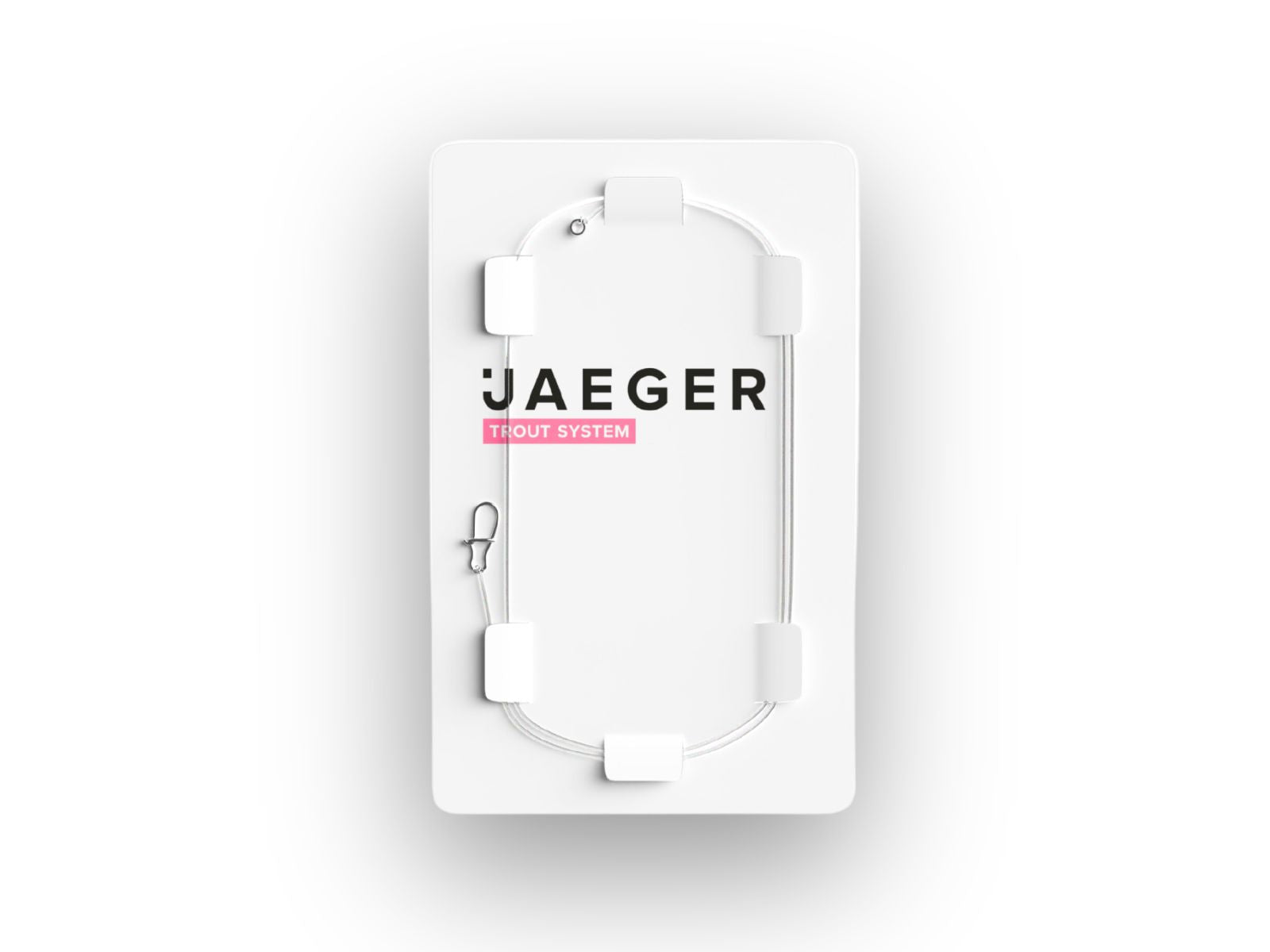
SNAP RIG – Trout Leader with Snap
★★★★★ (3 reviews)
Switch your spoons and spinners in seconds without retying knots. The SNAP RIG is designed for anglers who want maximum efficiency and stealth. Ultra-thin fluorocarbon leader combined with a micro snap for easy lure changes without sacrificing natural presentation.
✔️ Fast lure changes: Save time and fish more.
✔️ Invisible leader: Fluorocarbon stays hidden underwater.
✔️ For: Stream and lake trout anglers wanting top stealth and speed.
Extra Tips Only Guides Will Tell You
✓ Mix rigs during a session. Start with spoons like the NEMA Spoon to locate active fish, then switch to SNAP RIG + bait for pressured trout.
✓ Adjust leader length. In clear water, use longer leaders (2–3 feet) on your Carolina Rig to avoid spooking trout.
✓ Use scent attractants with PowerBait or worms on SNAP RIG setups for more bites.
✓ Don’t ignore micro adjustments. Changing from a size 10 to size 12 hook can double your bites when Trouties are finicky.
| Rig | For Beginners | Presentation Style | When to Use |
|---|---|---|---|
| Carolina Rig | Yes | Natural bottom presentation | Trout hugging bottom or in deep holes |
| Split Shot Rig | Yes | Natural drift with or without spinner | Streams with current or shallow lakes |
| Inline Spoon Rig | Requires practice | Flashy, moving baitfish imitation | When trout are actively chasing prey |
Trout Fishing Spoons & Lures Explained
When it comes to fooling the Stream fish, spoons and spinners remain two of the most effective lure types in any angler’s arsenal. They might look simple, but understanding how and when to use them will dramatically increase your catch rate.
Spoons
Spoons are metal lures shaped to mimic the flash and flutter of an injured baitfish. As they sink or wobble through the water, they reflect light and create vibrations that the Stream fishs find impossible to resist. For trout fishing, lighter spoons in the 1/16 to 1/8 oz range are ideal for shallow streams or smaller ponds, while heavier models around 1/4 oz allow you to reach deeper lake sections where bigger fish hold during warmer months.
The JAEGER NEMA Spoon is a top choice here. Its precision-balanced body delivers a fluttering fall that looks exactly like a wounded minnow, triggering aggressive strikes. Colors like Aqua Pearl and Indigo Rose excel in clear water, while Black Lime is deadly when the light dims or water turns stained.

Spinners to Catch Trout
Spinners work differently. Instead of a wobble, they create flash and vibration through a rotating blade, imitating small fish or insects darting through current. They are particularly effective in streams and rivers where trout wait in ambush for prey to drift past. Retrieve speed is key: in cold water, a slow steady retrieve is best, while in summer you can speed up to provoke reaction strikes.
The JAEGER SALTA Trout Spinner stands out because of its ultra-responsive blade design. Even on the slowest retrieve, it keeps spinning, sending out irresistible flashes. Its proven color options – Aqua Pearl, Indigo Rose, and Black Lime – give you flexibility to match conditions perfectly.

Softballs don´t work?
Many anglers overlook softbaits for trout, but small worms, grubs, or special magnets can be game changers, especially when the fish become pressured or ignore flashy metal lures. Softbaits excel when fished with finesse, dead drifting in current or twitching gently in still water to mimic natural prey. For example, if these speckled beauties refuse your spinner, switching to a 1-inch pink trout magnet on a micro jig head often converts follows into confident bites.
Choosing the right color and size is crucial. In clear water, natural tones like silver, black, or Aqua Pearl are ideal. In murky conditions or low light, bright colors like chartreuse, gold, or orange stand out better. Size matters too, cause aggressive trout respond to bigger spoons and spinners that create a strong presence, while finicky trout require downsizing to micro spoons or smaller blade baits for a subtle approach.
Why choose SALTA and NEMA? Unlike generic tackle store lures, SALTA and NEMA are engineered by anglers for anglers. Each lure is perfectly weighted and balanced for maximum flash, vibration, and casting distance, with premium hooks that land every strike. They’re built to catch fish when ordinary spoons and spinners fail.
Seasonal Trout Fishing Guide
River rockets behavior changes dramatically with the seasons. Knowing where they hold and how they feed in each period will help you plan trips that actually deliver fish, not just casting practice.
Spring
Spring is prime time for trout fishing. As waters warm after winter, trout move into shallow areas to feed and spawn. You’ll find them near gravel beds in streams or close to shorelines in lakes. They’re aggressive and easier to catch with flashy lures like the JAEGER SALTA Spinner or natural bait like worms drifted under a float. Early spring is also the perfect time to try nymphs or wet flies for pre-spawn trout holding in runs and riffles.
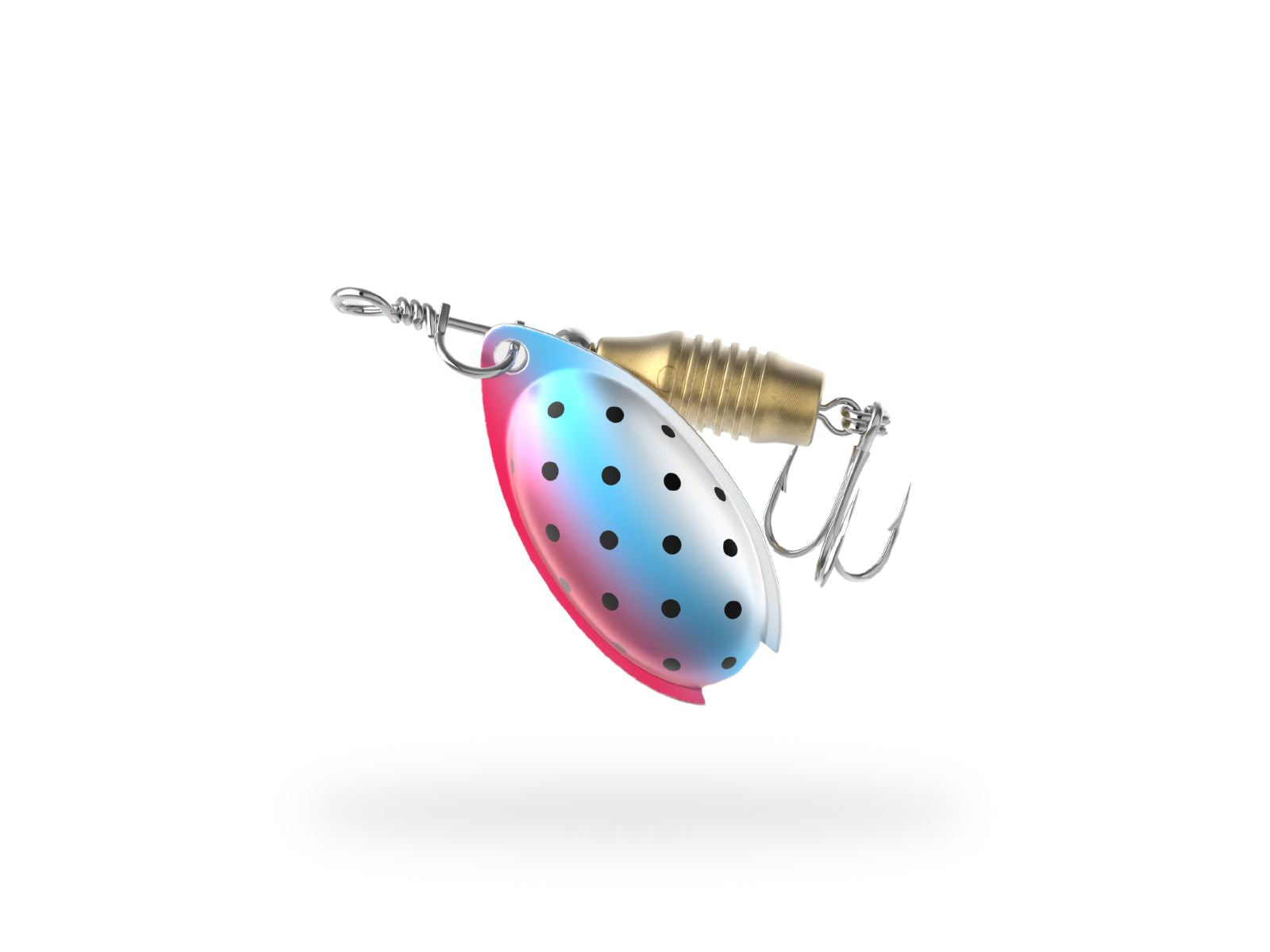
SALTA – Trout Spinner
★★★★★ (17 reviews)
The SALTA Spinner creates powerful flash and vibration to trigger trout strikes in any condition. Available in Aqua Pearl, Indigo Rose, and Black Lime.
Summer
When summer heat arrives, trout seek cooler, deeper waters to stay comfortable. In lakes, target deeper drop-offs and shaded areas early in the morning or late evening when trout come up to feed. During the day, bottom bouncing rigs with worms or using spoons like the NEMA to reach deeper layers work best. Streams will have trout hiding under undercut banks, log jams, or in faster oxygen-rich currents.
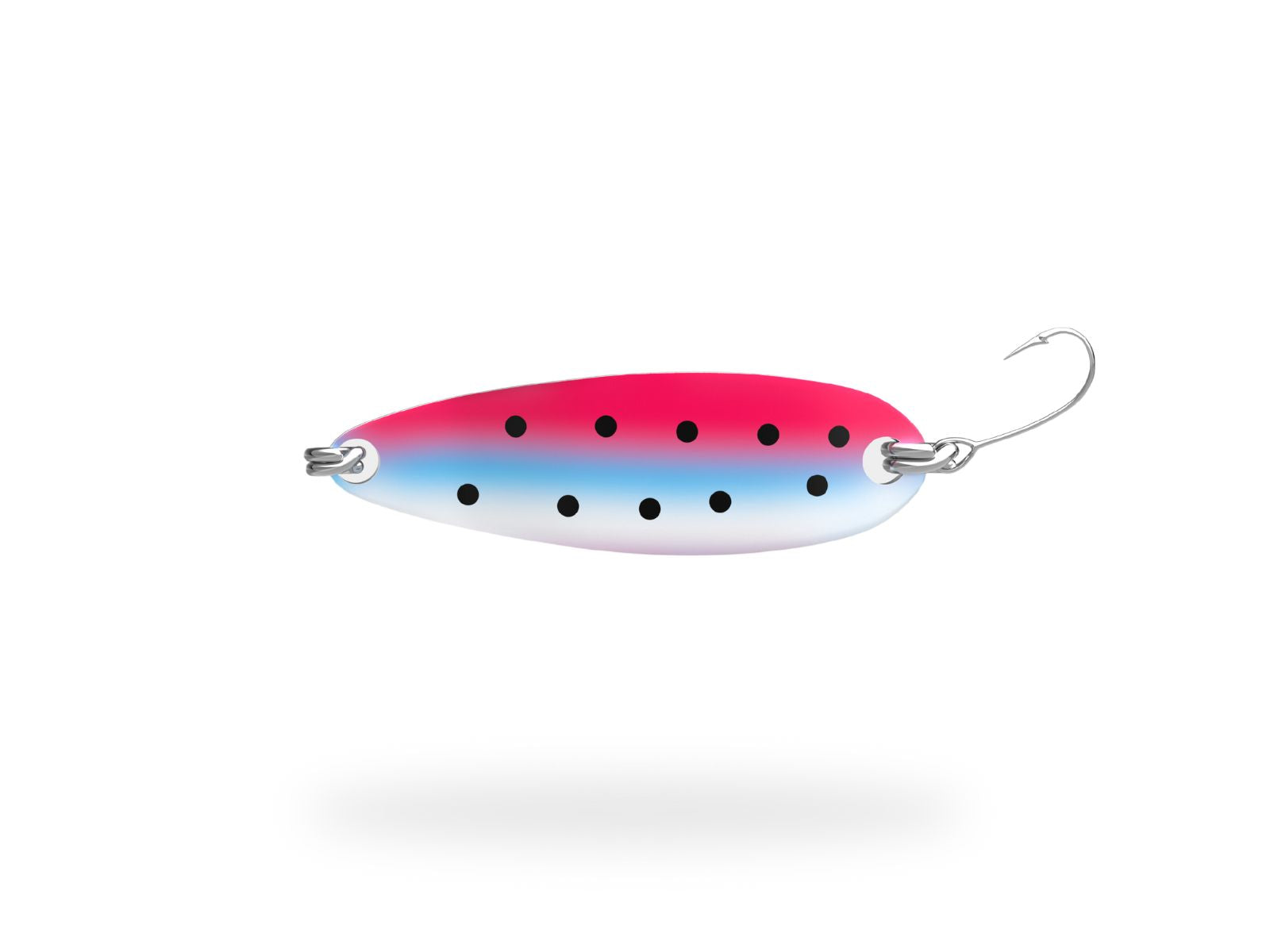
NEMA – Trout Spoon
★★★★★ (13 reviews)
The NEMA Trout Spoon delivers unmatched flutter action, mimicking an injured baitfish to trigger aggressive strikes. Designed for maximum casting distance and balanced to stay in the strike zone longer.
Fall
Fall triggers a feeding frenzy before winter. As temperatures drop, trout become more active and aggressive, trying to bulk up. This is the season for big bites on larger spinners, spoons, and streamer flies. Focus on moving baits with erratic retrieves to mimic baitfish trying to escape. Both rivers and lakes see increased trout activity, making fall an ideal time for ambitious anglers.
Winter
Winter trout fishing requires patience and finesse. Trout metabolism slows down in cold water, so they hold in deeper pools and slack water where they conserve energy. Use slow presentations like drifted nymphs, small spoons retrieved gently, or bait rigs with minimal movement. It’s all about keeping your offering in their face long enough to tempt them to bite.
Where to Fish for Trout Near You
These slime rockets can be found across almost every state, thriving in everything from fast-flowing mountain streams to deep, cold lakes. Whether you’re targeting wild ones or stocked fish, knowing where they hide and how to approach them makes all the difference.
Typical Spots: Pools, Runs, Riffles, Transitions
-
Pools: Deeper, slower-moving sections where trout rest while waiting for food to drift by.
-
Runs: Medium-depth stretches with steady flow, ideal feeding grounds for hungry Trouties.
-
Riffles: Shallow, fast-moving water rich in oxygen and insect life, where smaller Trouties often feed actively.
-
Transitions: Areas where riffles meet pools or where current breaks around rocks, these are prime ambush zones for bigger fish.
Lakes vs. Rivers – Tactical Differences
Fishing for trout in lakes requires a different approach than in rivers. In lakes, trout roam widely, so covering water is key. Early mornings and evenings are usually the best times as trout move closer to shore to feed in cooler water.
In rivers and streams, precision and stealth matter more. Cast upstream and let your bait drift naturally with the current into pools or alongside seams. This presentation looks exactly like natural prey drifting by, making trout more likely to strike.
How to Find Trout
Structure
Submerged logs, boulders, and undercut banks offer cover and prime ambush points.
Current breaks
Behind rocks, bends, or eddies where they can rest out of the main flow while waiting for food.
Oxygen-rich zones
Faster runs and riffles hold it too, especially in summer when they seek well-oxygenated water.
Another key is matching the hatch. Observe what these fishs are eating, whether it’s small baitfish, insects drifting on the surface, or aquatic larvae. Match your lure or bait in size and color to what’s naturally available, and your hook-up rate will skyrocket.
5 Common Mistakes Trout Anglers Make
- ❌ Too heavy line
- ❌ Wrong lure size
- ❌ No spot changes
- ❌ Poor presentation
- ❌ Retrieving too fast

Trout Go Kit – Starter Combo
★★★★★ (20+ reviews)
Everything you need to catch trout, all in one kit. Includes an ultralight rod & reel combo, premium trout spoons & spinners like the SALTA and NEMA, plus leaders and snaps for quick rig changes. Perfect for beginners or anglers wanting a lightweight, grab-and-go trout setup.
Customer Reviews
★★★★★
06/23/2025 – Lea (PH)
Good product
I'll buy again
★★★★★
06/09/2025 – Vale (CH)
Thank you so much!
I´ll for sure buy again with Jaeger
★★★★★
05/29/2025 – Marco H. (CH)
Super
Catching a lot with that setup

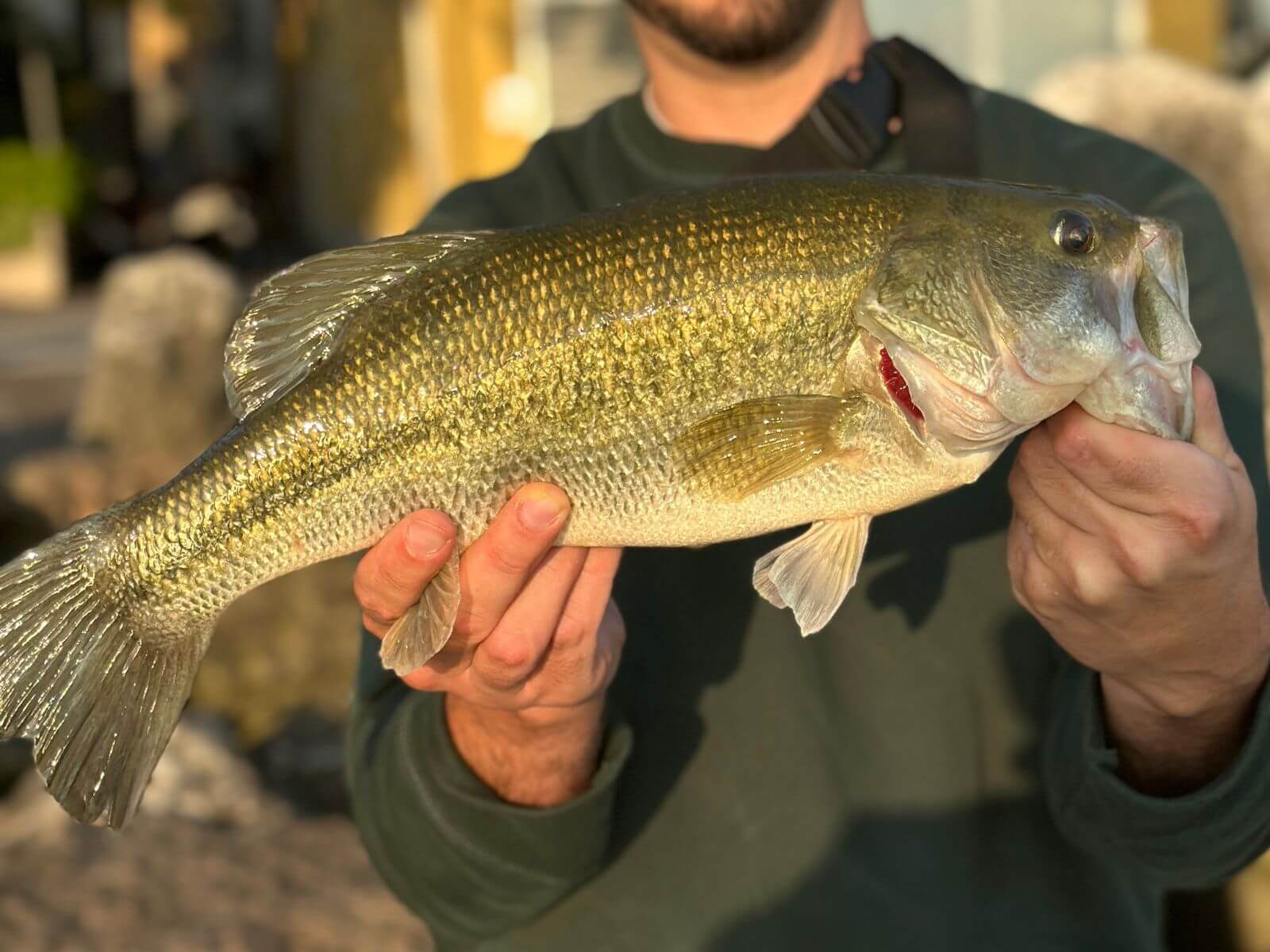
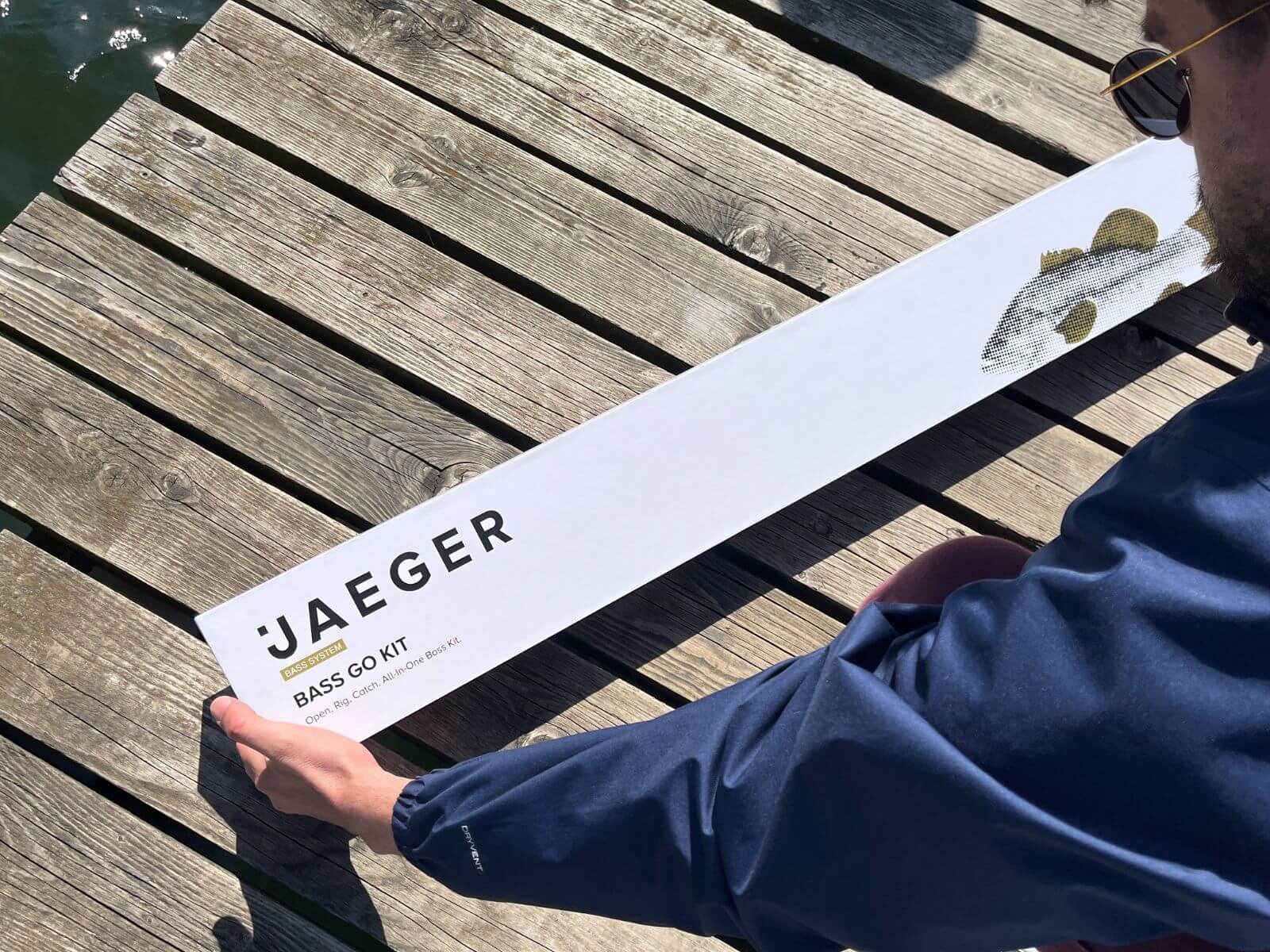
Leave a comment
This site is protected by hCaptcha and the hCaptcha Privacy Policy and Terms of Service apply.